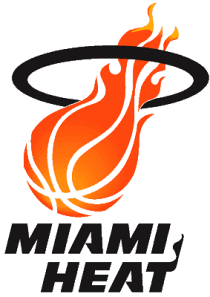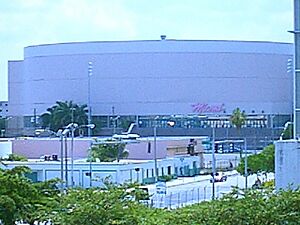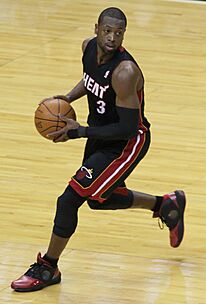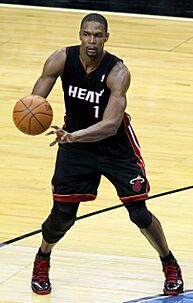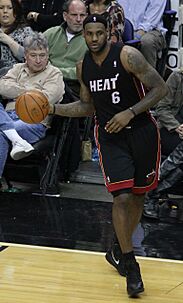History of the Miami Heat
The Miami Heat is a professional basketball team based in Miami, Florida. They joined the National Basketball Association (NBA) in 1988. The Heat quickly became one of the most successful NBA teams to join after the ABA-NBA merger.
After a few tough seasons, the team changed a lot in 1995 and 1996. This was under coach Pat Riley. They got new players like Isaac Austin and P.J. Brown. The Heat reached the Eastern Conference finals for the first time in 1996–97. They didn't get back to the conference finals until 2004–05. This was with new coach Stan Van Gundy and star player Dwyane Wade.
The next year, the team won the NBA Finals! They beat the Dallas Mavericks. Later, Erik Spoelstra became the head coach. In 2010–11, they reached the NBA Finals again but lost to the Mavericks. After LeBron James joined, they won the Finals in both 2012 and 2013. They even won 27 games in a row in 2013! In 2013–14, they reached the Finals again but lost to the San Antonio Spurs. James left in 2014, and the next season was not as good. After signing Jimmy Butler, the Heat returned to the NBA Finals in 2020, losing to the Los Angeles Lakers. They made it to the Finals again in 2023 as the eighth seed, but lost to the Denver Nuggets.
Contents
How the Heat Started (1987–1989)

In 1987, the NBA decided to add three new teams. Groups from Orlando, St. Petersburg, and Miami in Florida all wanted a team. The Miami group was led by NBA legend Billy Cunningham and sports agent Lewis Schaffel. They got money from Carnival Cruise Lines founder Ted Arison, who became the main owner.
In April 1987, the NBA chose teams for Charlotte and Minneapolis. They couldn't decide between Miami and Orlando. So, the NBA decided to add four teams instead! The Charlotte Hornets and Miami Heat started playing in the 1988–89 NBA season. The Minnesota Timberwolves and Orlando Magic started in the 1989–90 NBA season.
The team's name, "Heat," was chosen by a survey in 1986. Miami artist Mark Henderson designed the team's first logo.
The Heat started their first season in 1988–89 with many young players. They lost their first 17 games! This included a huge loss to Magic Johnson's Los Angeles Lakers. The team finished with a very bad record of 15 wins and 67 losses. This was partly because they were placed in the Western Conference, even though Miami is on the East Coast.
The Glen Rice Years (1989–1995)
The Heat picked Glen Rice in the 1989 NBA draft. They also moved to the Atlantic Division in the Eastern Conference. They stayed there for 15 years. But the team still struggled, finishing with an 18–64 record.
Even with new players, Miami kept losing. They finished 24–58. In 1991, the Heat hired Kevin Loughery as their new coach.
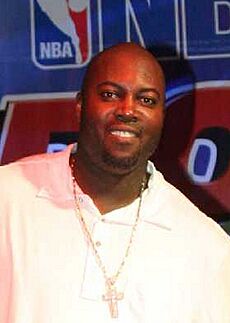
With new player Steve Smith and a more experienced Glen Rice, the Heat made the playoffs for the first time in 1991–92! They finished with a 38–44 record. They played the champions, the Chicago Bulls, and lost all three games. Steve Smith was named to the NBA All-Rookie team.
In 1993–94, the Heat had their first winning record ever, 42–40. They returned to the playoffs but lost in the first round. After this season, Steve Smith joined "Dream Team II," a group of NBA All-Stars who played for Team USA.
The Hardaway and Mourning Era (1995–2000)
The team's owners decided to sell their part of the team. Micky Arison, the son of the founder, bought the team in 1995. He wanted to make the Heat a championship team.
Pat Riley Arrives (1995–1996)
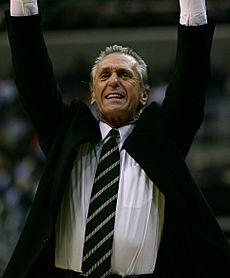
Arison hired Pat Riley to be the new head coach and team president. Riley quickly made big changes. He traded Glen Rice and other players to get All-Star center Alonzo Mourning. The Heat started the season by winning 11 of their first 14 games.
Later, Riley made more trades. He got Tim Hardaway, Chris Gatling, and Walt Williams. Mourning and Hardaway quickly became the main players for the Heat. Mourning was great at defense and rebounding. Hardaway was a fantastic point guard. They became one of the best duos in the league. The Heat finished with a 42–40 record and made the playoffs again. They were swept by the Chicago Bulls, but fans were excited for the future.
Reaching the Conference Finals (1996–1997)
In 1996, the Heat kept improving their team. They added P.J. Brown, Voshon Lenard, Dan Majerle, and Jamal Mashburn. Pat Riley turned the Heat into a strong defensive team. They became known for working hard and playing together. They were called the "Road Warriors" because they won so many games away from home.
The Heat were the most improved team in the league. They won their first Atlantic Division title with a 61–21 record. This was the best regular season record in Heat history at the time. In the playoffs, they beat their rivals, the Orlando Magic, in a tough five-game series. On May 8, Riley was named NBA Coach of the Year.
In the next round, the Heat faced the New York Knicks. This started one of the most intense rivalries in NBA history. Both teams played very tough defense. The series was full of fierce competition. In Game 5, P.J. Brown and Charlie Ward got into a fight, leading to suspensions for several Knicks players. The Heat won Game 6 and then Game 7 in Miami, moving on to the Eastern Conference finals for the first time!
In the Conference finals, the Heat played the Chicago Bulls. They lost the series 4–1. Even though they lost, the Heat had their best season ever and were now seen as a team that could win a championship.
Knicks Upsets (1997–1999)
The Heat had another great season in 1997–98, finishing 55–27. They won the Atlantic Division again and were the #2 seed in the East. They faced the New York Knicks again in the first round of the playoffs. The series was tied 2–2. In Game 4, Alonzo Mourning and Larry Johnson got into a fight. Mourning was suspended for Game 5. Without their star player, the Heat lost Game 5 and were knocked out of the playoffs.
The next season (1998–99) was shorter due to a lockout. The Heat still played great, finishing with the best record in the East (33–17). Alonzo Mourning had an amazing season, leading the league in blocks and winning Defensive Player of the Year. They were the #1 seed in the playoffs and faced the #8 seeded New York Knicks again.
The series went to a deciding Game 5 in Miami. The Heat were leading late in the game. But Allan Houston of the Knicks made a lucky shot that bounced in at the last second. The Knicks won by one point! This was a huge upset. For the second year in a row, the Knicks knocked the Heat out of the playoffs.
Final Loss to New York (1999–2000)
The Heat changed their uniforms and logo for the 1999–2000 season. On New Year's Day 2000, they played their first game in the brand new American Airlines Arena (now Kaseya Center). The Heat had another strong regular season, finishing 52–30. Mourning won Defensive Player of the Year again.
In the playoffs, they swept the Detroit Pistons in the first round. This was the first sweep in Heat history. Then, they met the New York Knicks again in the second round. This was their fourth playoff series in a row against the Knicks. The series went to a Game 7 in Miami. The Heat were in control, but a mistake by Mourning allowed the Knicks to score. The Heat lost by one point again in the final seconds.
Rebuilding Years (2000–2003)
After losing to the Knicks three years in a row, Pat Riley decided the team needed changes. Alonzo Mourning was diagnosed with a serious kidney disease and missed most of the 2000–01 season. Even without him, the Heat had a winning record (50–32) and made the playoffs. Mourning returned late in the season, but the Heat were swept by the Charlotte Hornets. This ended the successful Mourning-Hardaway era.
The next two seasons were tough for the Heat. They missed the playoffs for the first time in Pat Riley's coaching career. Many of the older players left. In 2002–03, the Heat drafted Caron Butler. Mourning missed the entire season due to his kidney condition getting worse. The Heat finished with a 25–57 record. Pat Riley stepped down as head coach, but stayed on as team president.
The Rise of Dwyane Wade (2003–2006)
Dwyane Wade Arrives (2003–2004)
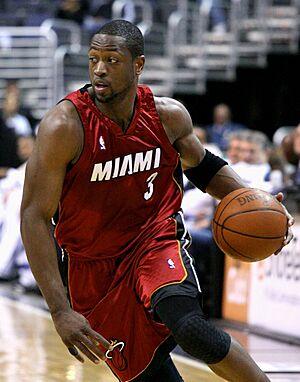
In 2003, the Heat had money to sign new players. They drafted Dwyane Wade from Marquette University with the 5th pick in the 2003 NBA draft. This was a bit of a surprise, as many thought they would pick a different type of player. They also signed Lamar Odom and Udonis Haslem.
A few days before the season, Pat Riley stepped down as coach and promoted his assistant, Stan Van Gundy. Many thought the team would be one of the worst in the league. But the new players, especially Wade, brought a lot of energy. Wade broke several rookie records. The Heat surprised everyone by making the playoffs! They beat the New Orleans Hornets in the first round, but then lost to the Indiana Pacers.
Shaquille O'Neal Joins (2004–2005)
After a good season, the Heat made a huge move. On July 14, 2004, they traded for superstar center Shaquille O'Neal from the Los Angeles Lakers. Wade and O'Neal became a powerful duo. Alonzo Mourning also returned to the Heat.
The Heat had their third-best record ever: 59–23. They also won 14 games in a row. They were the top team in the playoffs and swept their first two opponents. They reached the Eastern Conference finals again, playing the defending champions, the Detroit Pistons. The series was tied 2–2. Miami won Game 5, but Dwyane Wade got hurt. Without Wade at full strength, the Heat lost Game 6 and a close Game 7. They missed out on the Finals.
In the offseason, the Heat made more trades. They got Antoine Walker, Jason Williams, and James Posey. They also signed veteran guard Gary Payton.
First Championship Win (2005–2006)
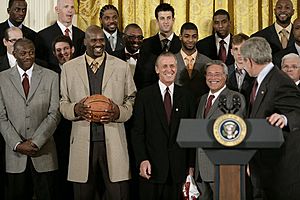
On December 12, 2005, Pat Riley became head coach again. The team played much better. Wade and O'Neal led the Heat to a 52–30 record, earning the 2nd seed in the Eastern Conference.
In the playoffs, the Heat beat the Chicago Bulls in six games. Then they beat the New Jersey Nets in five games. They reached the Eastern Conference finals again, facing the Detroit Pistons in a rematch. The Heat won Game 1 on the road. They took a 3–1 lead in the series. The Pistons won Game 5, but the Heat won Game 6 to reach their first-ever NBA Finals! They would play Dirk Nowitzki's Dallas Mavericks, who were also in their first Finals.
The Heat lost the first two games in Dallas. But Dwyane Wade led a comeback win in Game 3. Gary Payton made a key shot with nine seconds left. The Heat then blew out the Mavericks in Game 4. In Game 5, Wade scored 43 points, and the Heat won in overtime. With Pat Riley famously saying, "One suit, one shirt, one tie," the team went on to win Game 6 in Dallas, winning their first NBA championship!
They became only the third team in NBA history to win the Finals after being down 0–2. Wade won the Bill Russell NBA Finals Most Valuable Player Award. This championship was special for veterans like Alonzo Mourning and Gary Payton, who had never won an NBA title before.
After the Title (2006–2010)
First Round Sweep (2006–2007)
The Heat started the 2006–07 season badly. They lost their opening game by 42 points to the Chicago Bulls. This was the worst home loss in team history for a defending champion. Shaquille O'Neal missed many games with a knee injury. Coach Riley took a break. Dwyane Wade dislocated his left shoulder in February. Many thought the Heat would miss the playoffs.
But the team played well without Wade, winning 11 of 14 games. O'Neal played his best basketball. Wade returned in April, but he was rusty. The Heat finished with a 44–38 record and won their division. However, in the playoffs, the Chicago Bulls swept them 4–0. This was the first time a defending champion was swept in the first round since 1957.
Roster Changes (2007–2008)
After a disappointing season, the Heat made more changes. They traded Shaquille O'Neal to the Phoenix Suns for Shawn Marion and Marcus Banks. This ended the Wade-O'Neal era. The Heat finished with the worst record in the NBA at 15–67. Dwyane Wade also missed the end of the season to heal his knee and shoulder.
On April 28, 2008, Pat Riley stepped down as head coach but stayed as team president. He chose his assistant, Erik Spoelstra, to be the new head coach. At 37, Spoelstra became the youngest head coach in the NBA.
Rebuilding the Team (2008–2010)
In the 2008 NBA draft, the Heat got the #2 pick. They chose power forward Michael Beasley. They also got guard Mario Chalmers. The Heat signed local player James Jones as a three-point shooter.
On February 13, 2009, the Heat traded Shawn Marion and Marcus Banks for center Jermaine O'Neal. On April 3, 2009, the Heat made the playoffs! They went from 15 wins to 43 wins in one year. They lost in seven games to the Atlanta Hawks in the first round. However, Dwyane Wade led the league in scoring with 30.2 points per game, a first for the Heat.
The Heat started the 2009–10 season well but were inconsistent. They finished 47–35 and made the playoffs again. They lost in five games to the Boston Celtics in the first round.
The Big Three Era (2010–2014)
Before the 2010–11 season, the Heat made huge news. They signed two superstar players, Chris Bosh and LeBron James, to join local star Dwyane Wade. James announced his decision on TV, saying he would "take his talents to South Beach." This made many fans angry, especially in Cleveland.
Wade, James, and Bosh were called the "Big 3." They were introduced at a big party in Miami. James even predicted they would win "not two, not three, not four, not five, not six, not seven" championships.
Losing the Finals (2010–2011)
With all the hype, many thought the Heat would break the record for most wins in a season. But they started 9–8. There were rumors that Coach Spoelstra might be fired. After a team meeting, the Heat started playing much better. They won 12 games in a row.
Wade, James, and Bosh were all chosen for the NBA All-Star Game. The Heat finished the regular season with a 58–24 record, the second-best in the East. In the 2011 NBA Playoffs, Miami beat the Philadelphia 76ers, Boston Celtics, and Chicago Bulls, all in five games.
The Heat reached the 2011 NBA Finals for the first time since 2006. They played the Dallas Mavericks again. The Heat took a 2–1 lead, but then lost the next three games and the series. Much of the blame fell on LeBron James, who struggled in the Finals.
Second Championship Win (2011–2012)
Before the 2011–12 season, the Heat signed veteran Shane Battier. In the shortened season, the Heat started 27–7. James, Wade, and Bosh were again All-Stars. They finished 46–20, earning the second seed in the East.
In the 2012 NBA Playoffs, they beat the New York Knicks in five games. Then they faced the Indiana Pacers. Chris Bosh got injured in Game 1. The Heat fell behind 2–1 in the series. But James and Wade stepped up, often combining for 70 points, and the Heat won the next three games to beat the Pacers.
They met the Boston Celtics in the Eastern Conference finals. The Heat took a 2–0 lead, but then lost three games in a row. In Game 6 in Boston, James had an amazing 45 points and 15 rebounds, leading the Heat to a big win. In Game 7 in Miami, the Heat won 101–88, reaching the NBA Finals for the second straight year.
In the Finals, they played the Oklahoma City Thunder. The Heat split the first two games, winning Game 2 on the road. Then they swept the next three games at home to win their second NBA championship! James was named the Finals MVP, winning his first NBA title.
Making History (2012–2013)
In 2012, the Heat signed veterans Ray Allen and Rashard Lewis. The Heat became one of the few teams to have three All-Stars (Wade, James, and Bosh) for three years in a row.
The Heat achieved many milestones. Udonis Haslem became the first undrafted player to lead a team in rebounding. LeBron James became the youngest player in NBA history to score 20,000 career points.
On February 3, 2013, the Heat started an amazing winning streak. They won 27 games in a row! This was the second-longest winning streak in NBA history. During this streak, they beat every other team in the NBA. The streak ended on March 27 when the Chicago Bulls beat them.
The Heat finished the season with a franchise record 66 wins. They were the top team in the entire league. In the playoffs, they beat the Indiana Pacers in a tough Game 7 to reach the NBA Finals for the third straight year.
In the Finals, they faced the San Antonio Spurs. The series was back and forth. In Game 6, the Spurs were close to winning the championship. But LeBron James scored 16 points in the fourth quarter. With seconds left, Ray Allen hit a three-pointer to send the game to overtime. The Heat won in overtime. This game is considered one of the greatest Finals games ever. The Heat then won Game 7 to capture their second straight NBA title! James was named Finals MVP again.
Final Year of the Big Three (2013–2014)
The Heat kept most of their team together. They signed Greg Oden and brought back Michael Beasley. The 2013–14 season was a struggle for the Heat. They lost all their regular season games against the Brooklyn Nets and struggled against other top teams.
LeBron James had a career-high 61 points in a game against the Charlotte Bobcats, breaking Glen Rice's franchise record. The Heat finished with 54 wins, the second seed in the East. In the playoffs, they swept the Charlotte Bobcats in the first round. They then beat the Brooklyn Nets in five games.
In the Eastern Conference finals, they faced the Indiana Pacers for the third year in a row. The Heat won in six games, reaching the Finals for the fourth straight year! This joined them with the Boston Celtics and Los Angeles Lakers as the only teams to do this.
In the Finals, the Heat faced the San Antonio Spurs again. But this time, the Heat lost in five games. They lost by large margins in their losses. In Game 1, the air conditioning failed, and LeBron James had to leave the game due to cramps. On July 11, 2014, LeBron James announced he was returning to Cleveland, ending the Big Three era.
Wade's Final Years (2014–2019)
Missing the Playoffs (2015)
After LeBron James left, the Heat worked to stay a top team. Chris Bosh and Dwyane Wade re-signed with the team. They also signed new players like Luol Deng and Josh McRoberts.
The Heat started 3–0 but then struggled with injuries. On Christmas Day, LeBron James returned to Miami as a Cavalier. The Heat beat the Cavaliers, with Wade scoring 31 points. The Heat also signed Hassan Whiteside, who became a big contributor.
In February 2015, the Heat traded for Goran Dragić. But soon after, Chris Bosh was sidelined for the rest of the season due to blood clots in his lungs. The Heat failed to make the playoffs, finishing with a 37–45 record. This was only the second time in Wade's career that he missed the postseason.
2015–16 Season
In 2015, the Heat signed veteran Amar'e Stoudemire and rookie Justise Winslow. They also re-signed Wade and Dragić. In February 2016, they signed former All-Star Joe Johnson. For the second year in a row, Chris Bosh was out for the season due to blood clots. Deng, Dragic, and Wade stepped up to lead the team.
The Heat finished with a 48–34 record, earning the third seed in the playoffs. They beat the Charlotte Hornets in seven games in the first round. In the Eastern Conference semifinals, they faced the Toronto Raptors. The series went to Game 7, but the Heat lost in a blowout.
Dwyane Wade Leaves
In 2016, Dwyane Wade left the Heat to join his hometown Chicago Bulls. Wade felt the Heat didn't appreciate him enough during contract talks.
End of the Dwyane Wade Era (2018–19)
After playing for the Cleveland Cavaliers and Los Angeles Lakers, Dwyane Wade returned to the Miami Heat for the 2018–19 NBA season. On April 9, 2019, Wade played his last home game in Miami, scoring 30 points. In his final game the next night, Wade had his fifth career triple-double. His #3 jersey was retired on February 22, 2020.
Contending Again (2019–Present)
Return to the Finals (2019–20)
Jimmy Butler signed with the Heat before the 2019–20 NBA season. Butler was named Eastern Conference Player of the Week in December 2019. For the first time in six years, the Heat made it back to the NBA Finals! They defeated the Boston Celtics in the Eastern Conference finals. The Heat played six games in the Finals but lost to the Los Angeles Lakers.
First Round Sweep (2020–21)
The Heat faced the Milwaukee Bucks again in the playoffs. Even though they had beaten them the year before, this time the Heat were swept 4–0. They lost Game 1 in overtime, but the next three games were big losses.
First Seed in the East (2021–22)
The Heat came back strong the next season. With new players like Kyle Lowry and P.J. Tucker, the Heat finished 53–29. This secured them the first seed in the East for only the fourth time in team history. The Heat beat the Atlanta Hawks in five games and the Philadelphia 76ers in six. They returned to the Eastern Conference finals for a rematch against the Boston Celtics. However, they lost the series in seven games. In Game 7, Butler missed a shot that could have won the game.
Making History (2022–23)
After being the top team in the East the year before, the Heat had an average regular season in 2022–23. They finished 44–38, placing them 7th. They lost their first play-in game but then beat the Chicago Bulls to get the 8th seed in the playoffs. This meant they would face the Milwaukee Bucks, who had the best record in the NBA.
Many people didn't think the Heat could win. But Miami surprised everyone and beat the Bucks in five games! They became the sixth #8 seeded team to eliminate a #1 seeded team. Jimmy Butler scored a career-high 56 points in Game 5, breaking the Heat's playoff scoring record.
The Heat then beat the New York Knicks in six games, continuing their old rivalry. In the Eastern Conference Finals, the Heat faced the Boston Celtics again. The Heat took a surprising 3–0 lead! But then they lost the next three games, forcing a Game 7 in Boston. Many thought the Heat would be the first team in NBA history to lose a 3–0 playoff lead.
But in Game 7, the Heat started strong and never looked back. They defeated the Celtics 103–84, winning their first Game 7 on the road in team history. Miami also became only the second #8 seed team to reach the NBA Finals. Jimmy Butler was named Eastern Conference Finals MVP. The Heat went on to lose to the Denver Nuggets in five games in the Finals. Udonis Haslem, at 42 years old, became the oldest player to play in the NBA Finals. Haslem retired after the series.


